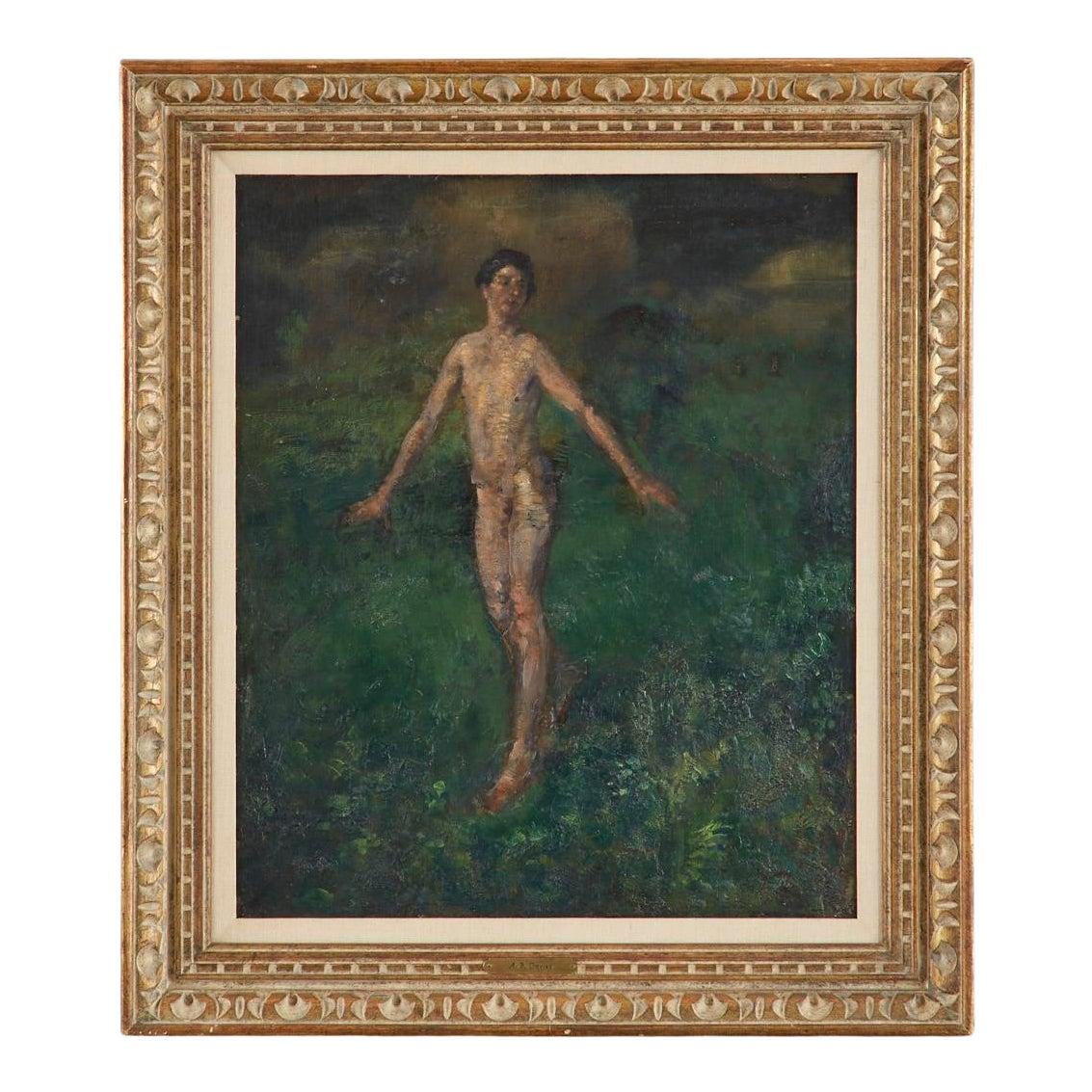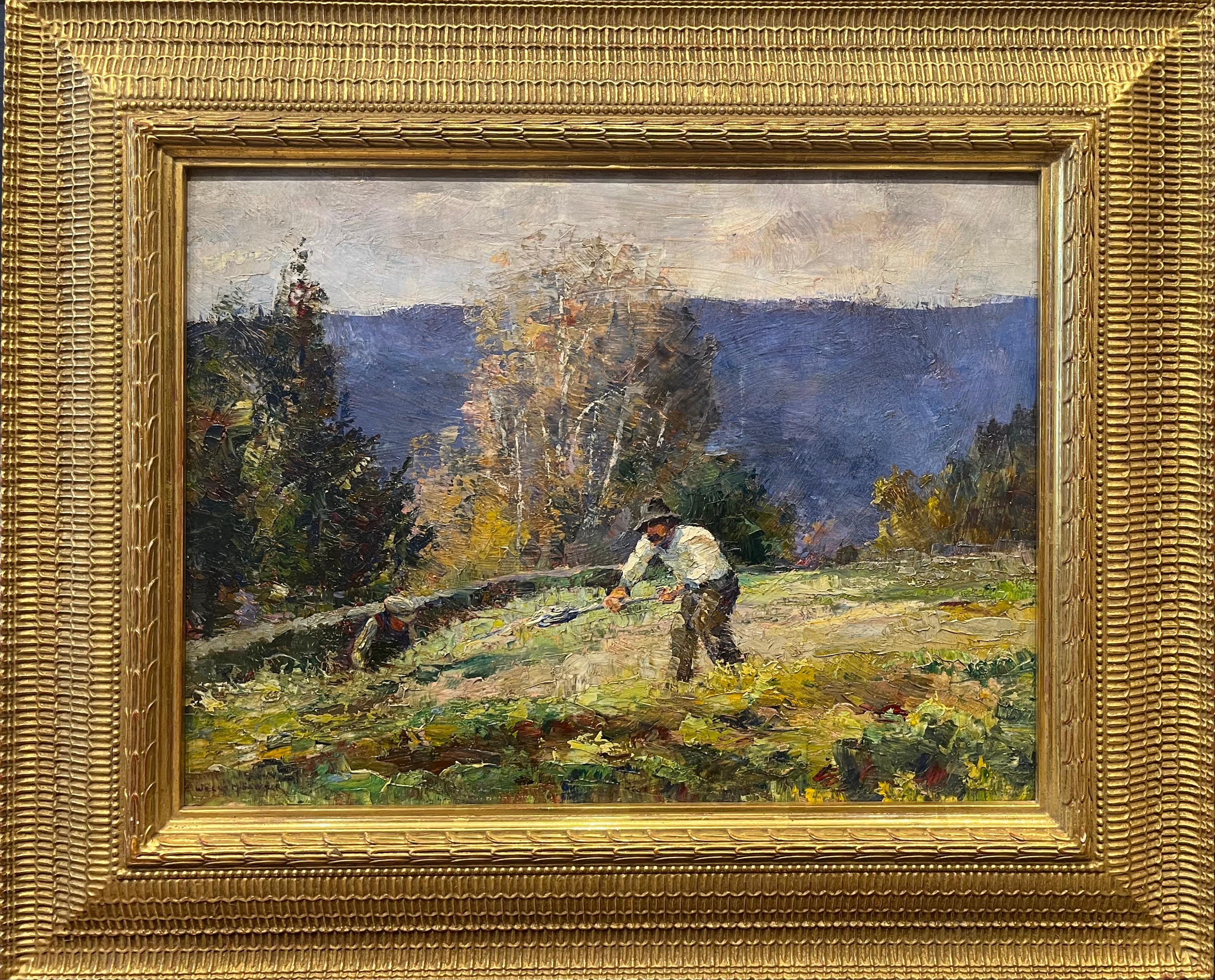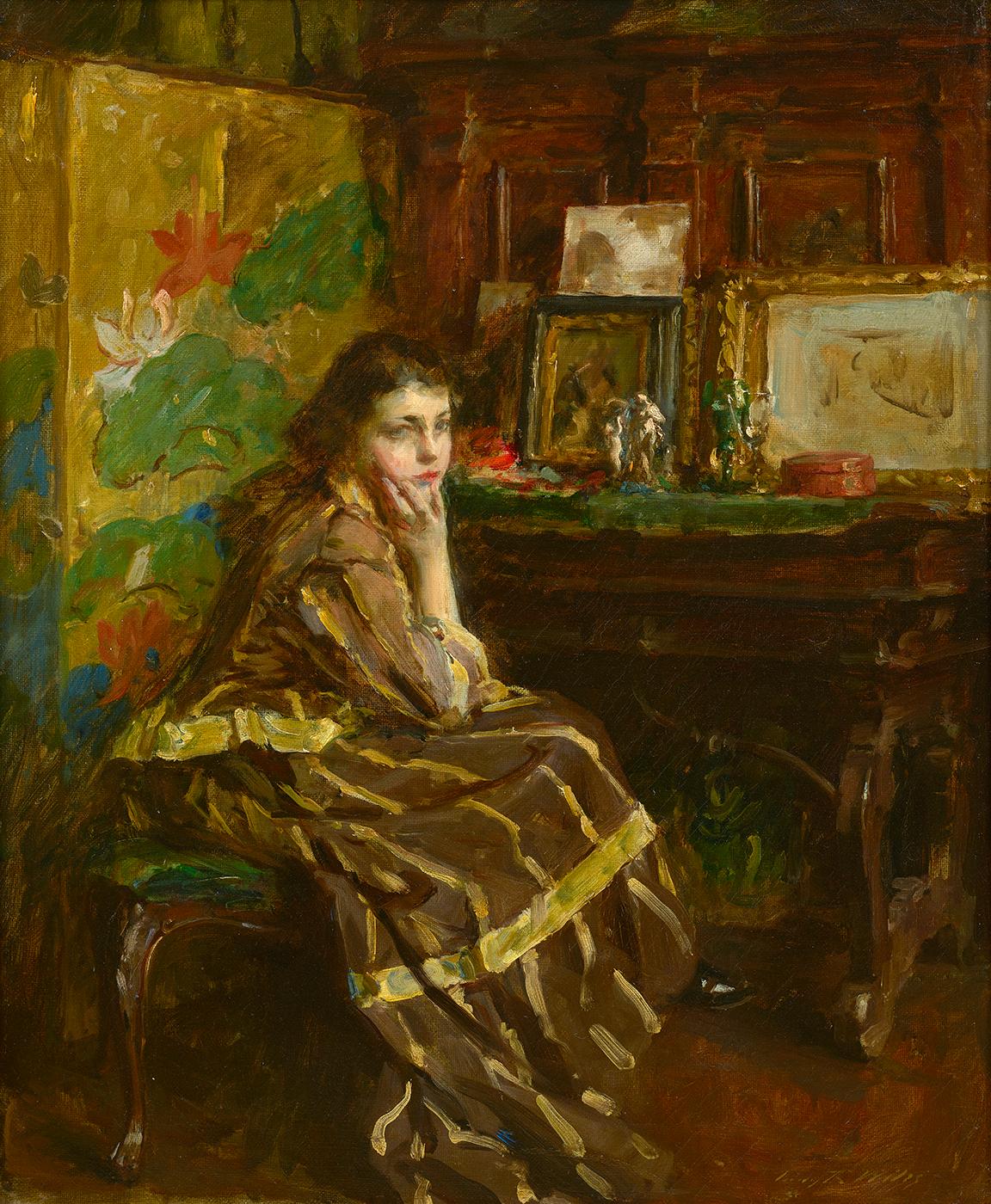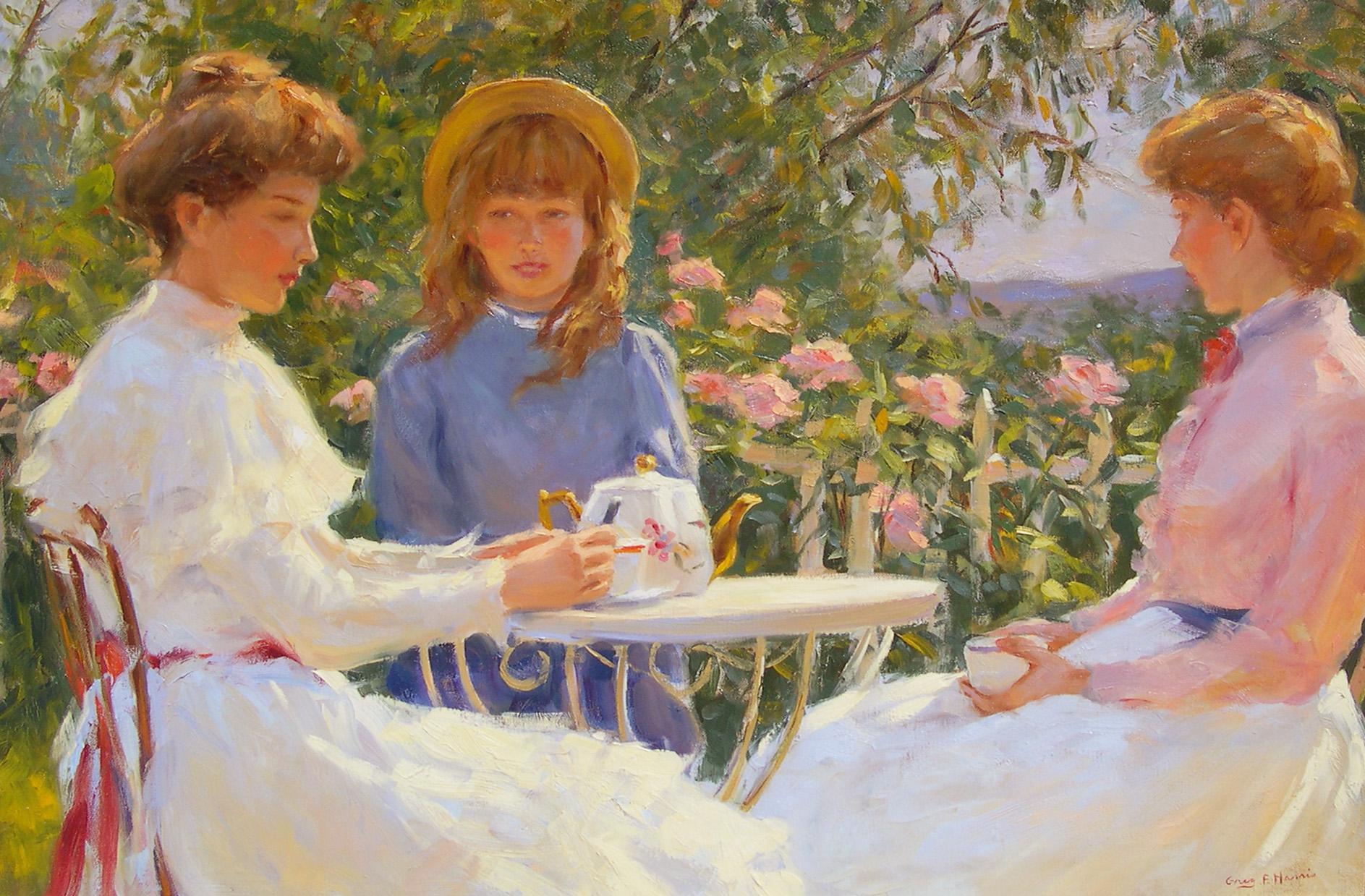Items Similar to "Portrait of Lady with Fan" Lilla Cabot Perry, Impressionist Female Artist
Want more images or videos?
Request additional images or videos from the seller
1 of 7
Lilla Cabot Perry"Portrait of Lady with Fan" Lilla Cabot Perry, Impressionist Female Artist
About the Item
Lilla Cabot Perry
Portrait of Lady with Fan, circa 1890
Oil on canvas
18 x 15 inches
Born in Boston, Lilla Perry was a key person, along with Mary Cassatt, in bringing French Impressionism* to the United States from France. For many years, she lectured, wrote, and encouraged American patronage of the style. She was also the artist most closely involved with the Guild of Boston Artists, which opened its galleries in 1914 to promote accomplished painters and sculptors. She served on the board as the first secretary and worked hard to cultivate persons for financial backing.
Perry had prominent Boston social credentials that included the Cabot and Lowell families. Her father was a distinguished surgeon; and her husband's great uncle, Commodore Matthew Perry, opened Japan to the world in 1853. In 1874, she married Professor Thomas Sergeant Perry, a professor of 18th-century literature, and their home became a gathering place for many Boston intellectuals including Henry James, William Dean Howells, and her brother-in-law, painter John LaFarge.
She had elite private schooling and began her art studies with Robert Vonnoh and Dennis Bunker at the Cowles School in Boston. Having first traveled to Europe with her family in 1887, she studied in France privately with Alfred Stevens and at the Julian and Colarossi Academies. She also exhibited at the salons and expositions and in 1889, attended Claude Monet's exhibition, "Impressions", which was a revelation for Perry, who decided to take up residence in Giverny.
In 1889, Perry and Cecilia Beaux visited Claude Monet at Giverny, France, and she was highly intrigued with his painting. He, who never took pupils, did give Perry advice and encouraged her to put down on canvas her first impression, saying that was the truest and most pure expression.
Between 1889 and 1909, she and her husband spent ten summer seasons in Giverny, where they lived next door to Monet and became close friends. Perry recorded interviews with Monet, who seemed very fond of her, and the result was Perry's book, published in 1927, Reminiscences of Claude Monet. She also successfully encouraged her wealthy friends to purchase Monet's paintings.
In 1889, she returned to Boston with one of Monet's paintings, Etretat, one of the first Impressionist works to appear in that area, and she was surprised that no one was very taken with the painting. Several years later, she gave lectures on Monet to the Boston Art Students Association.
In 1898, her husband, accepted a college teaching position in Tokyo, Japan as chair of English Literature, and living there until 1901, she painted the landscape and the people, completing more than eighty paintings. Of this period in her life, art historian William Gerdts wrote: "Lilla Perry was one of the most significant of the American painters who went to Japan in the late 19th century; . . . of all the Americans to work there, Perry's work is the least traditional and is the most indebted to the Impressionist aesthetic, and some of her Japanese scenes are, in color and brushwork, extremely close to Monet."
In her later years, she lived in the upper class Back Bay area of Boston, and spent her summers in Hancock, New Hampshire. Lilla was a founder and first Secretary of the Guild of Boston Artists. Much of her painting of that period was for her own enjoyment and focused on activities of upper class women, with her daughters frequently serving as the models. She seldom did any preliminary sketching, and pastel was a favorite medium.
- Creator:Lilla Cabot Perry (1848-1933, American)
- Dimensions:Height: 23 in (58.42 cm)Width: 20 in (50.8 cm)
- Medium:
- Movement & Style:
- Period:
- Condition:
- Gallery Location:New York, NY
- Reference Number:1stDibs: LU1841213812632
About the Seller
5.0
Platinum Seller
These expertly vetted sellers are 1stDibs' most experienced sellers and are rated highest by our customers.
Established in 2021
1stDibs seller since 2022
60 sales on 1stDibs
Typical response time: 1 hour
- ShippingRetrieving quote...Ships From: New York, NY
- Return PolicyA return for this item may be initiated within 3 days of delivery.
More From This SellerView All
- "Sensation in Wall Street, New York" Herman Hyneman, Jewish Artist, Gilded AgeBy Herman HynemanLocated in New York, NYHerman N. Hyneman (1849 - 1907) Sensation in Wall Street, New York, 1903 Oil on canvas 24 x 16 inches Signed and dated lower left Provenance: Roger King, Newport, Rhode Island Herman N. Hyneman was a noted American portrait and figure painter with ties to both Philadelphia and New York. He was born July 27,1849 to Leon and Adeline Hyneman in Philadelphia. ("Who Was Who in American Art" lists his birth date as either 1849 or 1859, but we have confirmed that the birth date is 1849). Virtually nothing is known about his early years, but given the fact that the family resided in a wealthy section of Philadelphia and the fact that he traveled to Paris to study in the studio of Leon Bonnat when he was but 20 years old, it is presumed that the family was financially comfortable if not well to do. Hyneman exhibited at the Paris Salon in 1879 and 1881, which was quite an accomplishment given his tender age. He returned to the United States in 1882 and after a year in Philadelphia, he established a studio at 58 West 57th Street, New York, NY, where he painted portraits to support himself and scenes of beautiful fair-skinned women walking in the snow to exhibit at major exhibitions throughout the United States. Hyneman exhibited at the the Brooklyn Art Association in 1882, 1883 and 1884 and at the Pennsylvania Academy of Fine Arts in 1883 and 1888. Beginning in 1882 and continuing up until 1905, he exhibited regularly at the National Academy of Design. Despite the fact that he exhibited fourteen paintings at the National Academy over a span of three different decades, he was never elected as a member. In the 1880's his paintings sold for between $100 and $1500, which were substantial sums for that period. Hyneman also exhibited at the Salmagundi Club and the Philadelphia Art Club and was a member of each organization. He won a medal at the American Art Society in 1904 and also exhibited at the Chicago Art Institute. A handwritten label on one of his paintings indicates that he also exhibited in Budapest, Hungary. In 1892, Hyneman married the noted artist Juliet Jolley (aka Jolly), who had previously modeled for him. Thereafter, they shared a studio and on at least one occasion exhibited together. The February 5, 1896 edition of the "New York Times" reported on a "pleasant studio reception" at 58 West 57th Street where the paintings of both Herman and Juliet were shown to members of New York Society including Mr. And Mrs. Edwin Blashfield. At least one of Hyneman's Painting " A Sensation on Wall Street" which depicted a lovely young woman in fur coat with Muff in front of the Stock Exchange, was made into a post card and reproductions of his paintings are known to exist, although not plentiful. At least one etching is known, "Desdemona," which was reproduced in a book by Frederic Stokes. Herman Hyneman...Category
Early 1900s American Impressionist Landscape Paintings
MaterialsCanvas, Oil
- "Elegant Lady in Winter, Trinity Church, New York" Herman Hyneman, Gilded AgeBy Herman HynemanLocated in New York, NYHerman N. Hyneman (1849 - 1907) Elegant Lady in Winter, Trinity Church, New York City Oil on canvas 22 x 15 inches Signed lower right Provenance: Freemans, 2005, Lot 76 Herman N. Hyneman was a noted American portrait and figure painter with ties to both Philadelphia and New York. He was born July 27,1849 to Leon and Adeline Hyneman in Philadelphia. ("Who Was Who in American Art" lists his birth date as either 1849 or 1859, but we have confirmed that the birth date is 1849). Virtually nothing is known about his early years, but given the fact that the family resided in a wealthy section of Philadelphia and the fact that he traveled to Paris to study in the studio of Leon Bonnat when he was but 20 years old, it is presumed that the family was financially comfortable if not well to do. Hyneman exhibited at the Paris Salon in 1879 and 1881, which was quite an accomplishment given his tender age. He returned to the United States in 1882 and after a year in Philadelphia, he established a studio at 58 West 57th Street, New York, NY, where he painted portraits to support himself and scenes of beautiful fair-skinned women walking in the snow to exhibit at major exhibitions throughout the United States. Hyneman exhibited at the the Brooklyn Art Association in 1882, 1883 and 1884 and at the Pennsylvania Academy of Fine Arts in 1883 and 1888. Beginning in 1882 and continuing up until 1905, he exhibited regularly at the National Academy of Design. Despite the fact that he exhibited fourteen paintings at the National Academy over a span of three different decades, he was never elected as a member. In the 1880's his paintings sold for between $100 and $1500, which were substantial sums for that period. Hyneman also exhibited at the Salmagundi Club and the Philadelphia Art Club and was a member of each organization. He won a medal at the American Art Society in 1904 and also exhibited at the Chicago Art Institute. A handwritten label on one of his paintings indicates that he also exhibited in Budapest, Hungary. In 1892, Hyneman married the noted artist Juliet Jolley (aka Jolly), who had previously modeled for him. Thereafter, they shared a studio and on at least one occasion exhibited together. The February 5, 1896 edition of the "New York Times" reported on a "pleasant studio reception" at 58 West 57th Street where the paintings of both Herman and Juliet were shown to members of New York Society including Mr. And Mrs. Edwin Blashfield. At least one of Hyneman's Painting " A Sensation on Wall Street" which depicted a lovely young woman in fur coat with Muff in front of the Stock Exchange, was made into a post card and reproductions of his paintings are known to exist, although not plentiful. At least one etching is known, "Desdemona," which was reproduced in a book by Frederic Stokes. Herman Hyneman...Category
Late 20th Century American Impressionist Landscape Paintings
MaterialsCanvas, Oil
- "The Green Parasol, " Henry Hannig, American Impressionist, Woman in Beach SceneBy Henry HannigLocated in New York, NYHenry Charles Hannig (1883 - 1948) The Green Parasol Oil on canvas mounted on board 6 x 7 3/4 inches Provenance: R.H. Love Galleries, Chicago, Illinois Private Collection, Lake Orion, Michigan Hannig, born in Hirschberg, Germany on 27 February 1883, came to America with his parents at the age of seven. He attended school in the southwest suburbs before the family settled in Chicago. Young Henry enrolled in the Chicago Academy of Fine Arts where Lawton Parker became his mentor. He made ends meet by working in industrial design and illustration. By 1908 he was a pupil in the School of the Art Institute of Chicago where students followed the traditional European drawing curriculum, beginning with the copying of master engravings and drawing after plaster casts, then concentrating on the nude figure. Students worked toward the goal of winning various academic prizes. One of Hannig's fellow students was Louis Ritman...Category
1910s American Impressionist Figurative Paintings
MaterialsCanvas, Oil, Board
- "A Man in His Garden, " Emil Carlsen, Backyard and Barn Impressionist LandscapeBy Emil CarlsenLocated in New York, NYSoren Emil Carlsen (1848 - 1932) A Man in His Garden, 1893 Oil on canvas 28 3/4 x 35 1/2 inches Signed and dated lower right Provenance: The artist [1848-1932] Macbeth Gallery, New ...Category
1890s American Impressionist Landscape Paintings
MaterialsCanvas, Oil
- "The Letter, " Frederick Boston, Woman Reading, American Impressionism FigurativeBy Frederick James BostonLocated in New York, NYFrederick James Boston (1855 - 1932) The Letter Oil on canvas 20 x 16 inches Signed lower left The first instructor of art at the Brooklyn Institute of Arts and Sciences, Frederick ...Category
Late 19th Century American Impressionist Figurative Paintings
MaterialsCanvas, Oil
- "The Pensive Beauty, " Carl Nordell, American Impressionism, Female PortraitBy Carl NordellLocated in New York, NYCarl Nordell (1885 - 1957) The Pensive Beauty Oil on canvas 40 x 32 inches Signed lower left Nordell was born in Copenhagen on 23 September 1885. In 1892 the Nordell family settled in Westerly, New Jersey, where Carl Johan, one of several children, received his education. Reportedly, a local gambler and art collector, Richard Canfield was so impressed with young Nordell's talent that he assisted him to gain admittance to the Rhode Island School of Design. Carl was a tireless student and serious in his studies of art, literature, and philosophy. Friends nicknamed him "The American Frans Hals," as a result of his study of that Dutch master. After graduating from the school in 1905, Nordell continued his training at the Art Students League in New York City for the following two years. There he received criticism and instruction from George Bridgman (1864-1943), a noted teacher of anatomy, and Frank Vincent DuMond (1865-1951), a landscapist associated with Old Lyme. The popularity of Impressionism in America at this time had reached its peak, and the style was of paramount influence in Nordell's advanced studies. Around 1906, Nordell visited an exhibition of paintings by the Ten, most of whom were American Impressionists. Moved by the work of Tarbell and Joseph R. De Camp, he sought instruction from them at the School of the Museum of Fine Arts, Boston. Nordell worked diligently under Tarbell and experimented with the genre of women in interiors, or Intimism. In 1909, Nordell received the Paige Traveling Scholarship, which provided for two years of continued study in Europe. He became one of the hundreds of Americans to receive criticism from Jean-Paul Laurens at the Académie Julian in Paris. From this base, he made study trips to visit major museums and galleries in Italy, Holland, Spain and Germany and during this period Nordell's style reached a level of uniqueness, though he definitely remained under the general influence of French Impressionism. By the time of his return to Boston in 1911, Nordell had successfully incorporated the use of broken color, a high-keyed palette, and the practice of working en plein air to achieve an accurate representation of light and atmosphere. In October of that year, the Boston Art Club presented eighty-seven of Nordell's watercolors and oils to the viewing public. Some of the watercolors seem revolutionary in their spontaneity. Nordell continued his career in Boston at Fenway Studios and exhibited in national competitions, including the annuals of the National Academy of Design, the Art Institute of Chicago; at the 1912 biennial of the Corcoran Gallery he won the fourth Clarke Prize. Nordell's finances were augmented by portrait commissions of some of Boston's affluent citizens. The artist was so intent on recording the sitter's likeness that in this genre, he deviated from his usual impressionist technique. In the women-in-interior genre, he frequently depicted a fully draped woman seated in profile or at an oblique angle to the picture plane. These pensive and attractive young ladies usually gaze into space and become an integral part of the pleasant ambiance of the scene. In this way, Nordell remained within the Genteel Tradition as it was manifest in Boston. The artist exhibited several such works in the Panama-Pacific International Exposition in San Francisco in 1915, and won a silver medal for his efforts. In 1918, a one-man exhibition of fifty works was presented at the Boston Art Club. Nordell remained active in the Boston area art clubs and societies through the early 1920s. In the winter of 1921 Babcock Art Galleries presented him with yet another one-man show. During this period, Nordell increased the production of prints and won the Salmagundi Club's Shaw Prize for etching in 1923. Sometime after 1927 he began taking summer sketching trips to Chautauqua Lake...Category
Early 20th Century American Impressionist Figurative Paintings
MaterialsCanvas, Oil
You May Also Like
- Boy Oil on CanvasBy Arthur Bowen DaviesLocated in Rio Vista, CAExquisite oil on canvas painting by artist Arthur Bowen Davies (American 1862-1928). The work depicts a young nude man walking through a lush green, ethereal landscape. Thick earth-t...Category
19th Century American Impressionist Figurative Paintings
MaterialsOil, Canvas
- Oil Landscape of Man Plowing Field Titled The Garden in AutumnLocated in Fredericksburg, VAThis painting depicts the world famous Untermeyer Garden in Yonkers, New York. Sawyer was an American painter, illustrator, and photographer. He took photographs and made paintings o...Category
Mid-20th Century American Impressionist Landscape Paintings
MaterialsCanvas, Oil
- Montigny-sur-LoingLocated in New York, NYDated, signed, and inscribed lower left: 1876 WILL. • H • LOW MONTIGNY sur LoingCategory
Late 19th Century American Impressionist Figurative Paintings
MaterialsCanvas, Oil
- The Little Models (Reverie)By Irving Ramsey WilesLocated in New York, NYSigned lower right: Irving R Wiles; on verso: Irving R WilesCategory
Late 19th Century American Impressionist Figurative Paintings
MaterialsCanvas, Oil
- "No Place Like Home", Greg Harris, Original Oil, Figurative, Landscape, 24x30 inBy Greg HarrisLocated in Dallas, TX"No Place Like Home" By Greg Harris is a perfect example of his most sought-after paintings. Measuring 24x30 in., this painting has a woman dressed in white sitting in a field of flo...Category
1980s American Impressionist Figurative Paintings
MaterialsCanvas, Oil
- "Tea Party", Greg Harris, Original Oil, Figurative, Landscape, 24x36 in.By Greg HarrisLocated in Dallas, TX"Tea Party" By Greg Harris is a perfect example of his most sought after paintings. Measuring 24x36 in., this painting has two woman dressed in pink and white sitting down for tea wi...Category
1980s American Impressionist Figurative Paintings
MaterialsCanvas, Oil
Recently Viewed
View AllMore Ways To Browse
Salon Art With Women
Grace Kennison
Tom Keating
Von Gegerfelt
Italian Botanical Fern Prints
Fashion Illustration Framed
Girl Strong
Native Girl
Source My Eye For Design
Florentine Angel Painting
Gigi New York
Abanindranath Tagore
Little Girl With Dog On Canvas
Salon Art With Women
Sad Man Painting
Francois Mengalatte
Ted Nichols
Modern Paintings From India




